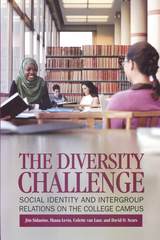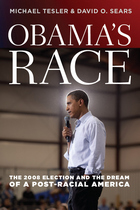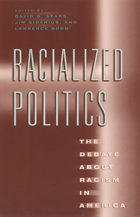

Barack Obama’s presidential victory naturally led people to believe that the United States might finally be moving into a post-racial era. Obama’s Race—and its eye-opening account of the role played by race in the election—paints a dramatically different picture.
The authors argue that the 2008 election was more polarized by racial attitudes than any other presidential election on record—and perhaps more significantly, that there were two sides to this racialization: resentful opposition to and racially liberal support for Obama. As Obama’s campaign was given a boost in the primaries from racial liberals that extended well beyond that usually offered to ideologically similar white candidates, Hillary Clinton lost much of her longstanding support and instead became the preferred candidate of Democratic racial conservatives. Time and again, voters’ racial predispositions trumped their ideological preferences as John McCain—seldom described as conservative in matters of race—became the darling of racial conservatives from both parties. Hard-hitting and sure to be controversial, Obama’s Race will be both praised and criticized—but certainly not ignored.

In Racialized Politics, political scientists, sociologists, and psychologists explore the current debate surrounding the sources of racism in America. Published here for the first time, the essays represent three major approaches to the topic. The social psychological approach maintains that prejudice socialized early in life feeds racial stereotypes, while the social structural viewpoint argues that behavior is shaped by whites' fear of losing their privileged status. The third perspective looks to non-racially inspired ideology, including attitudes about the size and role of government, as the reason for opposition to policies such as affirmative action. Timely and important, this collection provides a state-of-the-field assessment of the current issues and findings on the role of racism in mass politics and public opinion.
Contributors are Lawrence Bobo, Gretchen C. Crosby, Michael C. Dawson, Christopher Federico, P. J. Henry, John J. Hetts, Jennifer L. Hochschild, William G. Howell, Michael Hughes, Donald R. Kinder, Rick Kosterman, Tali Mendelberg, Thomas F. Pettigrew, Howard Schuman, David O. Sears, James Sidanius, Pam Singh, Paul M. Sniderman, Marylee C. Taylor, and Steven A. Tuch.

A tax revolt almost as momentous as the Boston Tea Party erupted in California in 1978. Its reverberations are still being felt, yet no one is quite sure what general lessons can be drawn from observing its course. This book is an in-depth study of this most recent and notable taxpayers' rebellion: Howard Jarvis and Proposition 13, the Gann measure of 1979, and Proposition 9 (Jarvis II) of 1980. The people of California, speaking directly through referenda, redirected their state from an intense and expensive concern for the welfare of its citizens to a far more circumspect role. The sequence involved cutting property taxes, limiting tax growth, and then rejecting a state income tax cut.
Why did Californians vote to lower some taxes and not others? How fundamental is the American disposition toward tax revolt? Will it happen again? The authors consider a variety of partial answers: the self-interest of certain groups, the apathy of others, the role of party affiliation, the specter of symbolic racism, the meaning of mass mood surges. The interplay between class politics and symbolic protest embodied in the California Tax Revolt has since spread to other states—for example, Proposition 21/2 in Massachusetts, which lowered property taxes—and has reached the federal level. President Reagan, with Republican and conservative Democrat support, has enacted major spending cuts and long-range tax relief. The new revolutionary strand in the fabric of the American political culture appears to be strong.

A tax revolt almost as momentous as the Boston Tea Party erupted in California in 1978. Its reverberations are still being felt, yet no one is quite sure what general lessons can be drawn from observing its course. This book is an in-depth study of this most recent and notable taxpayers' rebellion: Howard Jarvis and Proposition 13, the Gann measure of 1979, and Proposition 9 (Jarvis II) of 1980. The people of California, speaking directly through referenda, redirected their state from an intense and expensive concern for the welfare of its citizens to a far more circumspect role. The sequence involved cutting property taxes, limiting tax growth, and then rejecting a state income tax cut.
Why did Californians vote to lower some taxes and not others? How fundamental is the American disposition toward tax revolt? Will it happen again? The authors consider a variety of partial answers: the self-interest of certain groups, the apathy of others, the role of party affiliation, the specter of symbolic racism, the meaning of mass mood surges. The interplay between class politics and symbolic protest embodied in the California Tax Revolt has since spread to other states—for example, Proposition 21/2 in Massachusetts, which lowered property taxes—and has reached the federal level. President Reagan, with Republican and conservative Democrat support, has enacted major spending cuts and long-range tax relief. The new revolutionary strand in the fabric of the American political culture appears to be strong.
READERS
Browse our collection.
PUBLISHERS
See BiblioVault's publisher services.
STUDENT SERVICES
Files for college accessibility offices.
UChicago Accessibility Resources
home | accessibility | search | about | contact us
BiblioVault ® 2001 - 2024
The University of Chicago Press









